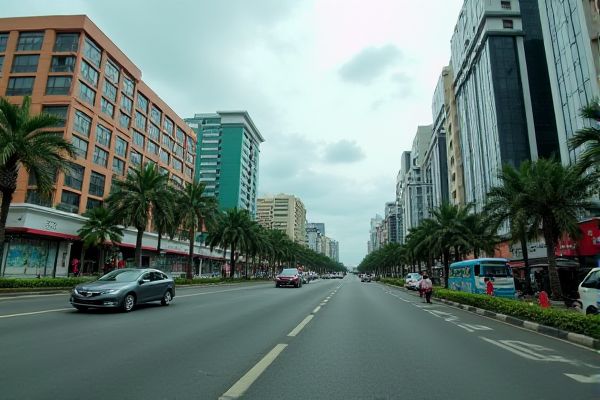
Internet and telecommunications options in Indonesia: Major providers: Telkomsel, Indosat Ooredoo, XL Axiata. Fiber optic networks available in urban areas. Mobile data packages affordable and widespread. 4G LTE coverage extensive throughout Indonesia. 5G networks introduced in major cities. Prepaid SIM cards easily accessible to foreigners. Online payment apps: GoPay, OVO, DANA. Popular internet cafes, "warnet," present countrywide. VoIP services: Skype, WhatsApp widely used. Internet speeds vary significantly by location.
Major providers: Telkomsel, Indosat Ooredoo, XL Axiata.
In Indonesia, the major telecommunications providers include Telkomsel, Indosat Ooredoo Hutchison, and XL Axiata. Telkomsel leads with substantial 4G coverage and a significant 5G rollout. Meanwhile, Indosat Ooredoo Hutchison has seen a notable revenue increase in 2023 driven by growth in data and interconnection services. XL Axiata has focused on network expansion, especially outside Java, achieving impressive revenue growth in the same year.
Fiber optic networks available in urban areas.
Fiber optic cables in Indonesia are predominantly available in major urban centers such as Jakarta and Surabaya, yet the expansion to rural areas faces significant logistical and financial challenges. Despite these issues, initiatives like the Palapa Ring Project are being implemented with the goal of extending fiber optic networks to more regions. Such efforts are crucial for building a connected Indonesia, ensuring that digital infrastructure and connectivity reach even the most remote areas, and ultimately fostering greater economic and social integration across the archipelago.
Mobile data packages affordable and widespread.
In Indonesia, travelers and residents can benefit from affordable mobile data packages offered by both eSIM providers and local operators. With eSIM services like Saily, users can easily activate plans starting from as low as $4.79 for a week, tapping into reliable networks with minimal hassle. Local operators such as IM3 Indosat, 3 (Tri), Smartfren, XL Axiata, Telkomsel, and Indosat Ooredoo also present enticing options, including prepaid SIM cards that provide generous data plans. For instance, options starting from $5 can get you 30 GB for a month, ensuring connectivity across the archipelago. Although some setups might require use of the Indonesian language, these services cater to diverse needs, offering additional benefits like unlimited calls and messages within their networks.
4G LTE coverage extensive throughout Indonesia.
As of the third quarter of 2019, approximately 93.58 percent of the cities in Indonesia had access to the LTE (4G) mobile network. This widespread coverage highlights the extensive advancements in digital infrastructure across the country. For more detailed statistics and insights into the Indonesia 4G Coverage by Administrative Region, you can explore further on the Statista website.
5G networks introduced in major cities.
In Indonesia, 5G networks have been introduced in major cities by Indosat Ooredoo Hutchison, covering areas such as Jakarta, Solo, Karawang, Bandar Lampung, Surabaya, Balikpapan, Makassar, and Bali, with applications in Smart City initiatives and industrial growth. Similarly, Telkomsel has expanded its Hyper 5G network across Greater Jakarta, including key routes and areas like airports and business districts.
Prepaid SIM cards easily accessible to foreigners.
Foreign tourists in Indonesia can easily obtain prepaid SIM cards by registering at the operator's customer service outlet using their passport or Limited Stay Permit Card (KITAS). For instance, Telkomsel's Tourist Prepaid Card can be pre-ordered online and collected upon arrival, offering various data quotas valid for 30 days. For more detailed information on acquiring prepaid SIM cards tailored for tourists in Indonesia, visit the comprehensive guide on Tempo.co, ensuring a seamless communication experience during your stay.
Online payment apps: GoPay, OVO, DANA.
In Indonesia, the top online payment apps include GoPay, OVO, and DANA, which dominate the market. GoPay, part of Gojek's super app, leads in terms of monthly active users, while OVO and DANA are significant due to their partnerships with major e-commerce and transportation platforms, and they are also considering a merger to enhance their market share.
Popular internet cafes, "warnet," present countrywide.
In Indonesia, internet cafes are commonly known as "warnet," an acronym for "warung internet," and they are widespread throughout both urban and rural areas. In bustling cities, these warnets are typically privately owned and offer a variety of services, including computer rentals, printer and scanner access, internet services, PC gaming, and even educational training. Conversely, in rural regions, these facilities often take the form of telecenters, which are government or donor-funded and provide essential internet and computer services to communities lacking personal access. To learn more about the global concept and function of internet cafes, you can visit the comprehensive explanation on Wikipedia, which offers a detailed overview of their evolution and impact worldwide.
VoIP services: Skype, WhatsApp widely used.
In Indonesia, while VoIP services like Skype are technically available due to the country's advanced telecommunications infrastructure, WhatsApp is the most widely used messaging and voice call app, with 140 million users relying on it for communication. However, specific details on the usage and availability of VoIP services such as Skype are not prominently highlighted, as WhatsApp dominates the messaging and voice call landscape.
Internet speeds vary significantly by location.
In Indonesia, internet speeds vary significantly by location, with Bali and Makassar leading in terms of mobile download speeds, reaching 38.49 Mbps and 40.37 Mbps respectively. In contrast, regions like Maluku Utara and Sulawesi Tenggara have the slowest speeds, highlighting a notable disparity in internet infrastructure across different provinces and cities. For more detailed insights on these variations, visit the Fastest Internet Speeds in Indonesia article, which explores the factors contributing to these differences.
